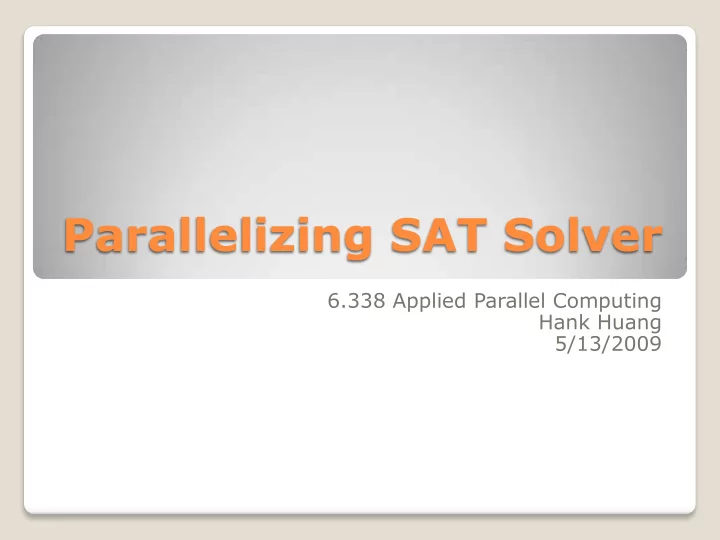

Parallelizing SAT Solver 6.338 Applied Parallel Computing Hank Huang 5/13/2009
The SAT problem: Given a formula made of boolean variables and operators, find an assignment to the variables that makes it true: ◦ i.e. (P v Q) ^ (~P v R) ◦ A solution: {P = false, Q = true, R = false} SAT is NP-Complete (Hard) What is SAT?
Conjunctive Normal Form is a set of clauses, each containing a set of literals Clauses are “ Anded ” with one another Literals are “ Ored ” with one another in a clause An efficient SAT solver takes a formula in CNF and returns an assignment as solution or says none exists SAT Solver
Naïve Solve: ◦ Enumerate assignments and check formula for each assignment ◦ For k variables, 2^k assignments! DPLL/Davis-Putnam-Logemann-Loveland ◦ Back-tracking ◦ Unit propagation ◦ Pure literal elimination More on SAT Solver
function DPLL( Φ , Env): ◦ if Φ is empty return Env; ◦ if Φ contains an empty clause return null; ◦ for every unit clause l in Φ Φ= unit-propagate( Φ ,Env); ◦ for every literal l that occurs pure in Φ Φ= pure-literal-assign(l, Φ , Env); ◦ l := choose-literal( Φ); ◦ Env2 = DPLL( Φ ,assign(l, Env)); ◦ If Env2 is null return DPLL( Φ ,assign(not(l), Env)); ◦ return Env2 Env is a map of assignments DPLL Algorithm
Sudoku Puzzle
Rules of the game ◦ No two same digit can appear in a single column ◦ No two same digit can appear in a single row ◦ No two same digit can appear in a single sub- grid ◦ Exactly one number must occupy each cell Sudoku Puzzle
For each column, row, sub-grid, cell: ◦ An At-least clause ◦ An At-most clause ◦ Together enforces exactly once behavior Example: ◦ An At-Least clause: [119 129 139 149 159 169 179 189 199]. ◦ An associated series of At-Most clause: ◦ [-119 -129], [-119 -139], [-119 - 149]…[ -119 -199] ◦ [-129 -139],[-129 - 139]…[ -129 -199] ◦ … ◦ [-189 -199] ◦ These 37 clauses together ensure that “9” appears exactly once in row 1. Reduction
Unit Propagation: ◦ (X)(X v Y v Z)(~X v Y)(Y Z ~W) (~Z W) (Y)(Y Z ~W)(~Z W) ◦ (Y)(Y Z ~W)(~Z W) (~Z W) ◦ Recursively searches the problem for a unit clause then simplify the problem accordingly in serial Pure Literal Elimination ◦ Tracks whether a literal has become pure at each step of recursion ◦ If so, simplify the problem accordingly Operations
Spread the problem across nodes Have each operations performed on sub- problem in parallel Obtain new sub-problem, and recurse Parallelization
Performance Comparison: Puzzle Number of Performance in milliseconds Number Recursion Steps Java Matlab Serial Matlab Star-P 1 145 76 89 4105 2 219 88 101 3809 3 732 148 168 5672 4 2644 465 481 12691 5 4052 858 912 19780 6 8234 1485 1674 24536 Performance
Sudoku is too small, too easy ◦ Computation requires is light ◦ Does not justify for communication cost Bigger problem more likely to see benefits of parallelization Conclusion
Recommend
More recommend